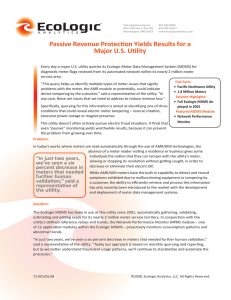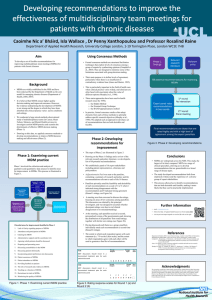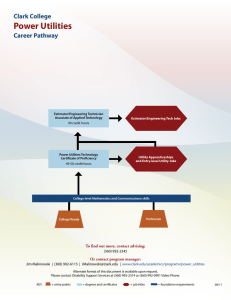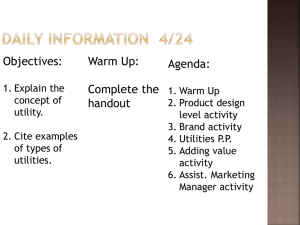Document 13128074
advertisement
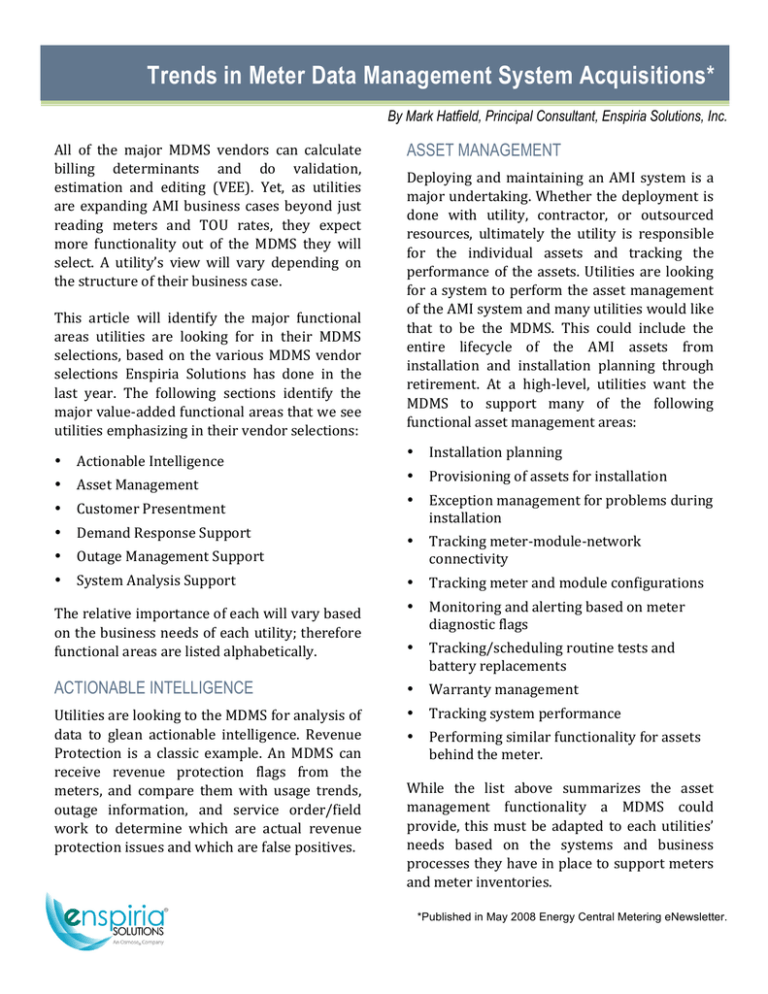
Trends in Meter Data Management System Acquisitions* By Mark Hatfield, Principal Consultant, Enspiria Solutions, Inc. All of the major MDMS vendors can calculate billing determinants and do validation, estimation and editing (VEE). Yet, as utilities are expanding AMI business cases beyond just reading meters and TOU rates, they expect more functionality out of the MDMS they will select. A utility’s view will vary depending on the structure of their business case. This article will identify the major functional areas utilities are looking for in their MDMS selections, based on the various MDMS vendor selections Enspiria Solutions has done in the last year. The following sections identify the major value-­‐added functional areas that we see utilities emphasizing in their vendor selections: ASSET MANAGEMENT Deploying and maintaining an AMI system is a major undertaking. Whether the deployment is done with utility, contractor, or outsourced resources, ultimately the utility is responsible for the individual assets and tracking the performance of the assets. Utilities are looking for a system to perform the asset management of the AMI system and many utilities would like that to be the MDMS. This could include the entire lifecycle of the AMI assets from installation and installation planning through retirement. At a high-­‐level, utilities want the MDMS to support many of the following functional asset management areas: • Actionable Intelligence • Installation planning • Asset Management • Provisioning of assets for installation • Customer Presentment • • Demand Response Support Exception management for problems during installation Outage Management Support • • Tracking meter-­‐module-­‐network connectivity • System Analysis Support • Tracking meter and module configurations The relative importance of each will vary based on the business needs of each utility; therefore functional areas are listed alphabetically. • Monitoring and alerting based on meter diagnostic flags • Tracking/scheduling routine tests and battery replacements ACTIONABLE INTELLIGENCE • Warranty management Utilities are looking to the MDMS for analysis of data to glean actionable intelligence. Revenue Protection is a classic example. An MDMS can receive revenue protection flags from the meters, and compare them with usage trends, outage information, and service order/field work to determine which are actual revenue protection issues and which are false positives. • Tracking system performance • Performing similar functionality for assets behind the meter. While the list above summarizes the asset management functionality a MDMS could provide, this must be adapted to each utilities’ needs based on the systems and business processes they have in place to support meters and meter inventories. *Published in May 2008 Energy Central Metering eNewsletter. CUSTOMER PRESENTMENT Utilities believe customer usage behavior can be changed if they have access to information on their consumption. It is the basis for implementing time of use rates and demand response programs. The MDMS is a crucial link in making consumption information available to customers. Some utilities are focusing on passive communication features such as web applets to present customers with consumption information and providing energy usage analysis tools to internal and external customers. Other utilities are focusing on presentment tools integrated with demand response programs to actively communicate events and thresholds to the customer. DEMAND RESPONSE SUPPORT The MDMS can potentially support demand response programs at various levels. At the most basic, the MDMS is the repository for historical consumption information and therefore is essential for utilities to track the effectiveness of any specific event or an overall program. In a more active role, the MDMS, through its asset management functionality, can maintain the asset information for any hardware associated with the demand response program — thermostats, control devices, etc. The MDMS data structures should enable the assignment of customers to specific demand response programs. Some utilities want the MDMS to assist in managing pre-­‐paid meters such as setting consumption thresholds, monitoring usage against the threshold and alerting at specific thresholds of usage. OUTAGE MANAGEMENT SUPPORT A high priority area for many AMI implementations is real-­‐time support to outage management. The basic process is simple. The MDMS receives and processes as many last-­‐ gasp statuses from individual meters as possible and supports verifying restoration to individual meters prior to closing the outage. But subtleties can improve an AMI system’s ability to support outage management. Utilities want the MDMS to filter known service orders to reduce false positives and to filter momentary outages. Utilities also want the MDMS to be able to throttle last gasp messages so that processing the events does not impact OMS performance, while still tracking all messages for asset history. Some utilities want to identify high priority or bell weather meters that will come through even if throttling thresholds are implemented. SYSTEM ANALYSIS SUPPORT With a fully deployed AMI, the MDMS is the repository for time scale load information by meter. Utilities want to be able to retrieve, aggregate, and transfer this information to system planning and load forecasting tools. The MDMS should support virtual meters that aggregate interval data for specified physical meters and potentially allow an external system to specify and manage the virtual-­‐ physical meter relationships. A more sophisticated implementation would allow network topology to be imported from the geographic information system (GIS) and allow a user to specify meter data aggregation to specific network devices. CONCLUSION In today’s market, if the utility’s focus is on using the MDMS to calculate billing determinants from the interval data, then the vendor selection can focus on price and relationship with the vendors. However, if the utility’s focus is on one or more of the value-­‐ added functional areas that can be provided by the MDMS, there are significant differences among the vendors. To achieve the goals of the expanded business case, the MDMS selection must focus on the utility’s priority value-­‐added area(s) with a detailed, yet realistic set of requirements. About the author Mark Hatfield is a Principal Consultant for Enspiria Solutions, Inc. with 22 years of professional experience including 13 years of experience in the energy/utility arena. He specializes in field automation, mobile workforce management, and geospatial systems for gas and electric utility operation, as well as meter data management systems, GPS field applications, geographic information systems, and construction work management systems, and business processes. He has an MA in Geography from the University of Illinois, and a BS in Geography from the US Air Force Academy.
